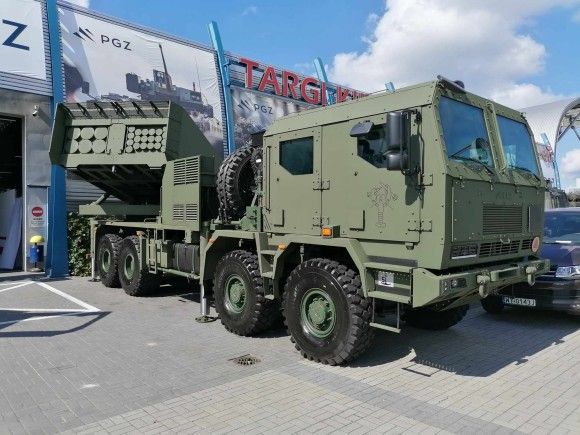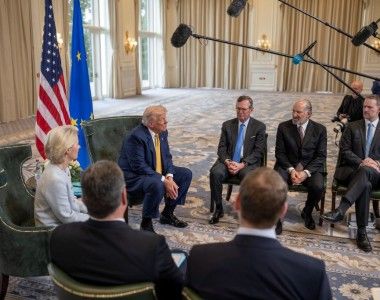Hanwha Aerospace CEO: Transfer of Technology a Key Element of Homar-K

Photo. Hanwha Aerospace
We have been collaborating with the Polish industry for 10 years, achieving standardization of solutions between Krab and K9 SPH. The future holds further joint opportunities for us, building on the possibilities of standardizing solutions and supply chains for components, which promotes further localization and even Europeanization of production - as Jae Il-Son, CEO Hanwha Aerospace, told Defence24.pl in an interview.
Jędrzej Graf, Defence24.pl: Poland has recently signed a second Execution Agreement for Chunmoo/Homar-K Multiple Rocket Launcher System, after a test firing of a Tactical Missile took place in the presence of the high-ranking Polish officials. What could you tell us about the contract, and what will be next steps to implement it?
Jae Il-Son, CEO Hanwha Aerospace: It was a great pleasure to host high-ranking representatives of the Polish government and military in South Korea. This visit, combined with a demonstration of the precision and reliability of our systems, was an excellent culmination of the next stage in our advanced cooperation, which has been ongoing for 10 years.
The 2nd Executive Contract is a continuation of the 1st Executive Contract for an additional 72 Launcher Modules with additional quantities of CGR-080 guided rockets and CTM-290 guided missiles, and a complete package of logistics, training and spare parts. The main difference is that unlike EC1, in EC2 Hanwha only provides the parts launcher modules while the local Polish partner will be responsible for the supply of the 72EA HOMAR-K Launcher through ToT.
In terms of ToT the 1st item is transfer of technology for launcher modules, which will be done step by step through the course of delivering the launcher modules. So every 12 launcher modules delivered will have a higher localization percentage than the previous delivery along the course of the contract performance. The 2nd item is transfer of technology for 130mm launch pod container technology, which will form the basis for the local Polish company to design, test and manufacture a launch pod container for 122mm unguided rockets. In the process, Hanwha will provide technical support for design of the LPC and participate in the testing and integration of the 122mm unguided rocket to enable firing from the HOMAR-K Launcher. So naturally, the next steps are getting export approval for ToT from South Korean government and moving forward with the Polish partner.

Photo. Defence24
The procurement of Homar-K has an industrial cooperation component from the first Execution Agreement, but in the second Execution Agreement it is going to be broadened. How would you describe the industrial cooperation with Poland in the Chunmoo project and what is the contribution of the 2nd Stage Agreement?
Industrial cooperation is one of the most important aspects of HOMAR-K contract. In 1st Executive Contract, Jelcz provided the vehicle, Hanwha supplied the launcher module, HSW performed the assembly and WB supplied/integrated the TOPAZ with Hanwha to create the HOMAR-K Launcher. All this was done is a period of less than 12 months.
I am sure for all parties involved, it was a great experience and I am thankful to the Polish partners involved for their hard work and support to make the HOMAR-K successful.
The ToT contribution for 2nd Executive Contract is as mentioned before, which is additional localization of the launcher module and integration of 122mm unguided rocket with HOMAR-K Launcher. Hanwha is very excited to again work with the Polish partners to fulfill the obligations set forth in EC2.
The Framework Agreement calls for the manufacturing of 239 mm guided rockets in Poland, which is now planned for the 3rd Execution Agreement. What are the steps required to finalise the project for the 3rd Execution Agreement? Do you currently plan to establish a Polish-Korean joint venture
The intention of both governments is joint production including transfer of technology, which will certainly be implemented as a key element of Homar-K. Specific moves, possibly in the form of agreements, can be expected in the coming months.
With the Polish partner, a feasibility study will be performed, which will then be submitted to Armaments Agency for review and approval. All business models are being explored.
Do you see possibilities of further cooperation between Poland and Hanwha on the Chunmoo/Homar-K system, including production of another guided missile / guided rocket in Poland, such as the newly developed 300 mm missile, or an integration of another missile delivered by a 3rd party to Homar-K?
It is natural progression that, as part of knowledge and technology transfer in Poland, the production of the 239 mm rocket is being launched. The subsequent step arising from this is to utilize this knowledge for further development.
We aim for future developmental versions to be even better suited to the expectations and needs of the Polish military. We believe that achieving this overarching goal must occur through close cooperation with the Polish defense industry, military institutes, and the broader scientific community.
Do you see any export opportunities specifically for Homar-K configuration which has been adapted to European markets and European/NATO requirements both in terms of chassis (vehicle) and the Fire Control System. And more generally, what role do you see for the Polish industry in Chunmoo exports for the third markets?
The integration of the K239/Homar-K launcher with 122 mm caliber rockets, carried out at the request of the Polish Armed Forces, naturally generates interest from other Central and Eastern European countries that use or produce such armaments. If any of these countries decide to enhance their defense capabilities with Chunmoo systems, it is evident that we will be keen to utilize the capabilities created/available in Poland, i.e., involving Polish companies in the execution of potential orders.
The second Execution Agreement for Homar-K of April 2024, as well as the second Execution Agreement for K9 howitzer for Poland, are conditional on the financing. How could you comment on that, are you optimistic that the financing matters will be settled?
We are in regular contact with representatives of the Polish government. It appears that the entire process will proceed smoothly. We are particularly grateful for the commitment shown by the Polish government, including the Ministry of National Defense, the Ministry of Finance, and the Polish Development Fund. What can go wrong with such support?

Photo. Adam Świerkowski/Defence24
How do you assess the progress of the Polish K9A1 delivery project? Have you received any feedback from the soldiers?
The Polish K9A1 delivery project is progressing well, with deliveries being made on time and in accordance with the contract.
All deliveries have been made on time. Our project team has a good track record of meeting deadlines and is confident that they will be able to deliver the remaining items on time.
I have heard from our Polish Hanwha Aerospace Coordinators that the artillerist have been very positive about the quality of the equipment, which they have described as modern, reliable and easy to use. They have also been impressed with the level of support provided by the local technical support team and field service groups. The service has been described as efficient and flexible. As far as I know, the Polish military has been very satisfied with the project to date. They have praised the quality of the equipment, the timeliness of deliveries, and the level of support provided. The project is on track to meet its objectives.
Several months ago, Hanwha Aerospace has presented a concept of a Polish supply chain for K9PL howitzer, that would eventually be manufactured in Poland. What is the stage of preparation of a supply chain for K9PL: both for maintenance, which is included in the 2nd Execution Agreement, and for the production of howitzers, which is included in the 3rd Execution Agreement. And how can Polish industry participate in Hanwha exports of K9 howitzers both in Europe and globally, particularly in the context of K9 User Club?
As a global leader, Hanwha Aerospace must be proactive and aware of certain conditions that may affect users of our systems. This could involve supply issues or transport route restrictions during international tensions. Therefore, Hanwha Aerospace’s goal is to ensure the availability and production of spare parts in Europe. Poland is naturally a priority partner in this regard due to longstanding successful cooperation and a large number of self-propelled howitzers used by the Polish Armed Forces. The involvement of the Polish industry in securing logistics for other European armies using the K9 seems like a logical next step.
We have been collaborating with the Polish industry for 10 years, achieving standardization of solutions between Krab and K9 SPH. The future holds further joint opportunities for us, building on the possibilities of standardizing solutions and supply chains for components, which promotes further localization and even Europeanization of production, integrating EU entities in both servicing and manufacturing new Hanwha products for European markets.

Photo. kpr. Piotr Szafarski / 16 Dywizja Zmechanizowana / MON
Beyond the K9 and Homar-K, what opportunities for Hanwha Aerospace do you see for the Polish market, not only in the military but also for the dual use, civilian systems? And what are the key R&D project areas of Hanwha Aerospace now? How could the Polish industry contribute?
Hanwha Aerospace is currently focused on key R&D project areas aimed at advancing both military and civilian systems. Our goal is to foster collaborative efforts with Polish scientific and research institutions to develop local defense and civilian technologies, which we believe are pivotal for nation-building. This strategic partnership aligns with our commitment to innovation and sustainable growth in Europe, integrating local capabilities and expertise into our global operations.
Founded in 1977, Hanwha Aerospace has emerged as a prominent leader in South Korea’s aerospace, defense, and marine industries. We emphasize customer-centric quality management and technological innovation, which have propelled us to the forefront of global aerospace and defense sectors. Our extensive experience and advanced technologies enable us to pioneer breakthroughs in space launch vehicles, aircraft engines, electric propulsion systems, and advanced ammunition, among others.
In collaboration with Polish industry, we aim to explore new frontiers in research and development, focusing on enhancing local defense capabilities and advancing technological ecosystems. This initiative not only strengthens bilateral ties but also contributes to the broader European defense and aerospace landscape. By integrating Polish expertise and resources, we envision co-creating innovative solutions that will shape the future of defense technologies and bolster regional security.
Together with our partners in Poland, we are dedicated to fostering a strategic alliance that drives technological advancements and reinforces our commitment to excellence in global aerospace and defense industries.
Furthermore, we are part of the Hanwha Group, whose business portfolio is very extensive. This includes renewable energy, economic transformation to ensure high energy efficiency, and a commitment to sustainable development for future generations. Hanwha Ocean not only delivers warships but primarily focuses on civilian vessels, including Floating Storage Regasification Units (FSRUs), tankers, and gas carriers, which help build energy independence for nations.
And here we come to a kind of conclusion that reflects our hopes for the future. We see tremendous potential in long-term cooperation that will result in jointly offered projects for mutual benefits of Poland and South Korea.
Thank you for the conversation.



